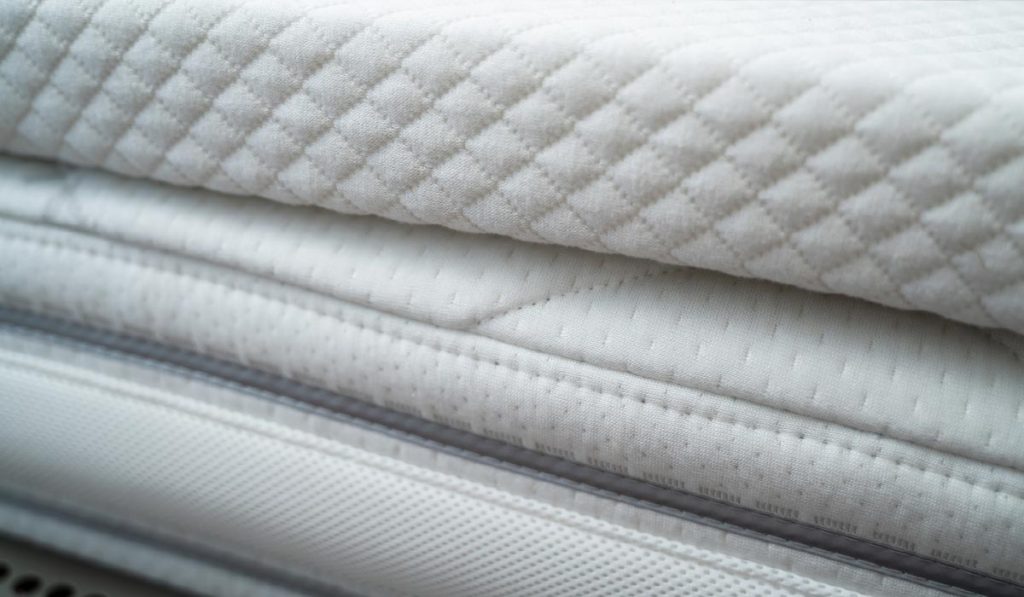People buy mattress toppers for all the right reasons… To make a firm bed a little more comfortable and vice versa. Our whole objective is to avoid back pain, so we buy them to use on beds that are either too firm or too soft to alleviate pain and discomfort.
But are mattress toppers good or bad for your back? A mattress topper that’s suited to your needs is likely to be good for your back, while a mattress topper that’s not suited to your needs is likely to be bad for your back. To get a topper that’s likely to be good for your back you need to consider your sleeping position as well as the firmness level of your mattress.
At the end of the day, pain and discomfort can interfere with our much-needed sleep. And when that happens, it can make a big difference in how the rest of our day goes. So, to start the day off on a good note, let’s learn as much as we can about mattress toppers to see if we’re using them as effectively as we can.
What Is A Mattress Topper?
Mattress toppers are a thinner type of mattress that you place on top of your existing mattress. They are designed to make your bed more comfortable. They are often about 4 to 8 inches thick and provides you with extra softness and comfort.
How Do I Know if a Mattress Topper Good or Bad For my Back?
If you’re still experiencing body aches even after using a mattress topper, it may be that you didn’t purchase the one that was best suited for your needs. To make sure you end up with a topper that suits your personal preferences and needs, it’s important to consider the following when purchasing.
1. Sleeping Position
It’s important to know the type of sleeper you are. Are you a stomach sleeper, back sleeper, side sleeper, or a combination sleeper who switches between back and side-sleeping during sleep?
Since most of us are side sleepers, we’ll start there. A thicker mattress topper (2 to 4 inches) seems to work better for side sleepers because of the number of pressure points being touched during the night.
Stomach sleepers may do better with a mattress pad than a topper, which is thinner and less supportive than a topper. But if you choose a topper, it should be a thin, barely-there topper.
It’s not as simple for back sleepers as back sleepers have unique needs that a topper can help or harm. First, it’s important to have the right firmness of mattress, and then try a topper if all else fails.
2. Mattress Firmness / Topper Thickness
Do you know the level of firmness of your mattress? Is it medium-firm, firm or ultra/soft plush? Since your mattress topper will be going on top of your mattress, it’s important to know the firmness to know if the topper will be beneficial.
Also, keep in mind that a mattress topper is thick and can add a significant few inches to your mattress. You may also need to buy sheets to accommodate it. So remember to check the thickness of the topper. Even this could make a difference in how it makes you feel.
These are just some of the questions you should be trying to answer when purchasing your mattress topper. Consult with the manufacturer or mattress staff while shopping to ensure you are purchasing one that best meets your needs.
Why Buy a Mattress Topper?
There are many benefits to having a mattress topper, and many people have found them to enhance their sleeping experience, and they wake up feeling more rested. These are the most common reasons:
- To lengthen the life of your mattress or add a layer of comfort if it’s too firm. However, understand that a mattress topper will not fix a sagging mattress or revive one that is well past its prime.
- To relieve pressure points and provide a more comfortable rest for people with chronic pain, a temporary injury, arthritis, fibromyalgia, or other musculoskeletal problems.
- Many mattress toppers are designed to help you stay cool while you sleep. Sleeping at a nice, cool temperature can result in more restful, higher quality sleep.
- To ease the break-in period that sometimes occurs with a new mattress.
- A mattress topper’s primary purpose is not to protect your mattress from dirt, bacteria and dust. But it still does create an extra layer between your body and your mattress that helps to keep your mattress clean, which ultimately extends its lifespan.
Should I Get a Mattress Topper or do I Actually Need a New Mattress?

Sometimes we don’t realize we need a new mattress and we make the mistake of thinking we can fix up the one we have. And sometimes we can; a mattress topper can help with that. But all mattresses need replacing eventually, and it’s important to know when that time comes. You know it’s time to replace your mattress when you wake up with back pains.
Nowadays, just because a mattress is ten years old, is no indication that it needs to be replaced. Mattress material has come a long way, and it’s possible to have a mattress still in good condition for up to 15 years. A sure indication of whether or not it is time to go mattress shopping is how you feel when you wake up.
If you feel stiff or sore, and this is happening multiple times a week, it’s likely that it’s time for a new mattress. There could be different reasons for this — from wear and tear of the mattress to weight gain and lack of support.
If your mattress has big dips or impressions where you lay, that is also a surefire sign that the mattress is breaking down.
If you’ve purchased a mattress topper and are still experiencing back pain, consider the fact that it may be time for a new mattress.
How Can I Get The Most From My Existing Mattress?
Not all mattresses are made equally. The longevity of your mattress has a lot to do with the material it is made with. For instance, innerspring mattresses have the least lifespan of no more than ten years. Memory foam is more durable and can last up to 15 years. Latex has a lifespan of up to 20 years.
Related reading:
That said, how the mattress is maintained will determine if it will last its full cycle of life. Some things you can do to help ensure its longevity is to rotate it — turn it 180 degrees, so the head and foot are reversed — at least once a year, so the surface wears more evenly. If it’s a double-sided mattress it can also be flipped a couple of times a year.
You also want to ensure your mattress has the appropriate base for support. Also, you can never go wrong with a mattress protector (which is different from a mattress topper). A mattress protector helps protect the mattress from stains and sustain it from other things like rips, cuts, etc., that would constitute wear and tear on the mattress.
Lastly, if you’re pretty sure it’s not yet time to replace your mattress but wish it were a little cozier, you may want to consider getting a mattress topper.
The Various Types of Mattress Toppers

Just like mattresses, mattress toppers come in a variety of materials. Here are the most popular types:
1. Latex Mattress Toppers
Latex mattresses are a good option regardless of what type of sleeper you are. It’s often recommended by orthopedists and chiropractors for people who suffer from neck, back, or shoulder pain, because they’re firm enough to offer good support.
Natural latex mattress toppers are made from the liquid in rubber trees. Although not all latex mattress toppers are natural, be sure you thoroughly check before purchasing if it’s important for you to not have synthetic materials.
Our MemorySleep mattress topper is made of safe and eco-friendly latex that comes from rubber trees in Thailand. The MemorySleep topper is a latex and memory foam hybrid, where the latex provides great support, elasticity and resilience while the memory foam provides comfortable cushioning and pressure relief. If you’re interested in learning more about the topper you can do so over at our shop here.
2. Memory Foam Mattress Toppers
Memory foam is a polyurethan-based foam that softens when it comes into contact with body heat. It conforms to your body’s unique curves and provides pressure relief to any pain points. It’s extremely durable and provides support if you have back, muscular or joint pain. It’s most beneficial to side and back sleepers.
3. Wool Mattress Toppers
Wool is exceptionally breathable, which helps with temperature regulation for those who tend to get too hot or too cold at night. In warm weather, it wicks away sweat; when temperatures drop, it’s a good insulator. It is a naturally comfortable and soft material that is also durable. Wool has some good qualities but may not be the best at relieving pressure pain points.
4. Down/Down Alternative Mattress Toppers
Down and down alternatives are extremely soft to sleep on and the most breathable. They don’t offer much in the way of support or pressure relief.
How Should I Take Care of My Mattress Topper?
Once you decide to get a mattress topper, it’s important to maintain it, so how you clean it is very important. The best way to clean a mattress topper is to spot clean it. However, some toppers do come with removable and washable covers that you can take off and wash, and some are dry clean only.
Conclusion
In the end, a mattress topper can be a great decision to help alleviate back pain. They can be good for your back. However, if you have not purchased the right one or if you’re trying to revive an already un-revivable mattress, the topper won’t help and could make the situation worse. Make sure you’re purchasing a topper for the right reasons, and make sure it’s appropriate for your needs.
